November 03, 2010
By Tony Peterson
Restoring Faith in Your Shooting Ability.
By Tony Peterson
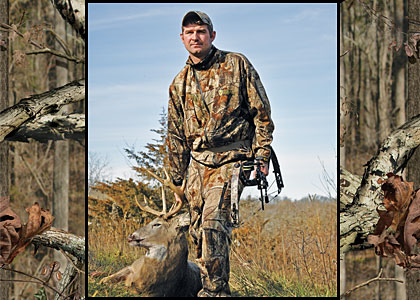 Few critters have a greater ability to rattle bowhunters than mature bucks. If a hunter already has issues with shooting confidence, an encounter with a true wall-hanger has a high likelihood of going sour. Hunters who become extremely comfortable with their equipment have a better chance of sealing the deal. |
The catalyst for the worst bowhunting season of my life was a 30-yard shot at a young doe. The release felt good, the hit looked solid and, presumably, the first antlerless tag had been filled. After a day and a half of looking for that deer, I gave up. The next afternoon, I found her lying in a hay field with entrance and exit wounds that looked like the shot should have been immediately lethal, and only slightly low. I thought it was a fluke, but it messed with my mind a little and started the utter disintegration of my shooting confidence.
Throughout the dismal season of 2008 I lost another deer, a 140-inch Kansas 8-pointer, and missed easy shots at two does, two Minnesota bucks, a turkey and a coyote. By November, my confidence was so low I was terrified to shoot at any deer, which was in direct conflict to my own personal greed that wanted redemption in the worst way. This greed made me want every deer I saw, and it felt like a personal slight every time a deer chose any path that didn't lead past my stand. If it sounds like losing my confidence to shoot straight in a hunting situation left me a bit mixed up, that's because it did in a bad way.
Advertisement
Immediately after that season, I began a quest to identify what went wrong and fix it. Reflection on the mistakes made, the game lost and the overall erosion of my confidence and hunting enjoyment led me to change my practice regimen, gear choices and general attitude. I can safely say 2009 went a heck of a lot better than the previous year!
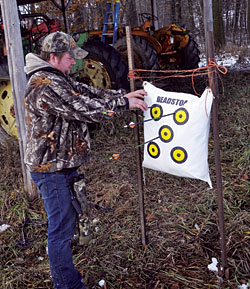 Most preach it, but few practice it. In-season practice is truly important. Firing as few as 10-15 arrows each day promotes muscle-memory and proper shooting form. This can help a hunter maintain shooting confidence during a long whitetail season.
Advertisement
|
All Practice, No Preaching
Target practice is important for obvious reasons, but there is one aspect that seems to fall through the cracks. Certainly it's crucial to shoot enough to understand your effective range and honest ability to hit what's aimed at, but developing a true feel for your bow, sight, release and arrows is important as well. Repetition leads to muscle memory and comfort with gear. After enough practice, a hunter can develop a shooting level that's basically like being on autopilot. During encounters with game, the ability to simply make a shot happen without worrying about it can lead to short blood trails. Conversely, when the moment of truth arrives and a hunter is not comfortable, the mind has an annoyingtendency to focus on what can go wrong instead of what can go right.
Reverse Engineer the Encounter
Clean misses are OK; wounded and consequently lost animals are not, even though they are an unavoidable aspect of our hunting pursuits. Every time a hunter launches an arrow, things happen that blur the lines between reality and what is remembered. It's important to note the obvious, such as game reactions and the route the animal ran after the shot, but also how the shot sequence felt. Analyzing a poor shot immediately after it's taken can aid in game recovery and provide valuable information about how not to make the mistake again. In the case of a season that has gone terribly awry, a string of blown opportunities can be the trail of breadcrumbs that leads a hunter to a game-changing epiphany. It might have something to do with equipment, but it probably has more to do with the mental state the archer was in when things started going wrong. Either way, dissecting all shot opportunities (good and bad) can help hunters avoid a dreadful season.
The New Gear Fix
Bowhunters are notorious for spending money on products that promise the shortest route to success. From scents to treestands and everything in between, we dole out hard-earned money on advertising promises and paid testimonials, oftentimes with disappointing results. That said, if a hunter has truly bad mojo going in the deer woods, it might be time to upgrade equipment.
My disastrous '08 season started with a bow designed for speed. A low brace height and seriously pre-loaded limbs made it smoking fast, but I never truly got comfortable with it. Simply put, the bow didn't fit my shooting style and I didn't enjoy shooting it. After several botched encounters with deer, I switched to a more whitetail-friendly setup, but it was too late to salvage the season. The point that seemed to be slowly driven though my skull during that season was something I've known all along -- shoot a bow you are comfortable with.
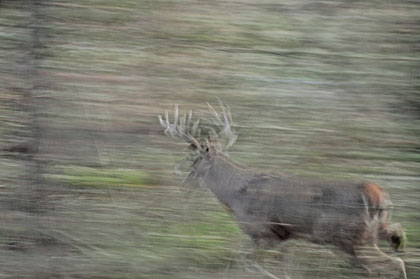 If this is what it looks like when a nice buck strolls in, you're not alone. An elevated heart rate and racing thoughts should accompany big buck encounters, but they don't need to detract from making a good shot if proper steps are taken. |
There are just certain pieces of our hunting arsenal that foster confidence, and aside from our bows, I'd say broadhead choice is a solid second-place contender. Broadhead designs spark heated debates among bowhunters from East to West, and individual heads gain loyal followings just as easily as they garner disdain from others. A lot of aspects concerning broadheads are highly debatable, but one thing that can't be ignored is how they fly out of your bow. Hunters who tune for broadheads and practice with every arrow they intend to hunt with (tipped with a broadhead) will develop confidence that can carry them through high-pressure shots.
Certainly, this also applies to stands that won't squeak or ping, sights that will stay bright and functional through any weather conditions and any other gear we employ in our pursuit of game animals. This is not to say a hunter should immediately blame a piece of equipment for failure, but is instead a recommendation on thoughts surrounding failed encounters. Did you miss that buck because you couldn't see your pins? Did your arrow look like it corkscrewed a little upon release? Was it difficult to hold your bow at full draw while a deer stood for a full minute surveying its surroundings? Nagging thoughts after a blown opportunity can be the clues that lead a bowhunter to equipment that favors his or h
er style of shooting and hunting, and this can foster much-needed confidence.
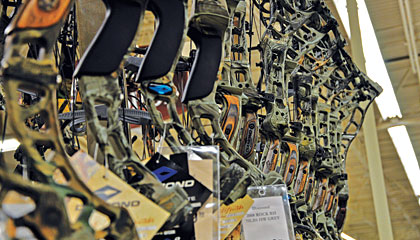 One blown opportunity does not warrant shopping for new gear, but a poor season might. Brand new equipment equals a fresh start in many ways, and can be the first step to wiping the slate clean. |
Set 'Em Up, Knock 'Em Down
It's impossible to know how many whitetails have escaped death simply because of poor stand setups. Shooting confidence issues compound exponentially the longer a hunter sits on stand thinking about how few shooting lanes he or she has. Worrying that a buck will pass by on a trail where the only shooting hole is the size of a softball is a great way to send a well-intentioned arrow sailing into the stratosphere and to lose the deer.
There's nothing more satisfying in the world of whitetails than sitting in a truly well-planned setup, with quality shooting lanes, entrance and exit routes and a comfortable seat. Eliminating things that can go wrong is a subtle way to boost shooting self-esteem, although the benefits are two-fold. The first is that when a whitetail walks in, the hunter typically has to worry about only one thing -- making the shot. The second is that properly designed stand sites promote easier shots, which is something every archer with an ounce of common sense should strive for.
Zen Masters
I've read a pile of hunting articles about developing an internal checklist or mantra while shooting so things will come naturally while aiming at live game. The authors often preached about not getting excited until after the shot, not looking at antlers, etc. That's fine and dandy for the guy sitting at his desk writing about hunting, but in the woods things tend to change. I've personally arrowed dozens of big-game animals and can say with the utmost sincerity that setting aside my excitement until after the shot is not possible. Neither is it possible for me to completely ignore antlers or horns, or count down a checklist in my head as a big buck walks by my stand.
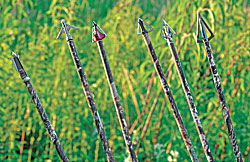 Simple things such as broadhead choice can affect a hunter's confidence. Knowing a broadhead-tipped arrow is going to fly well boosts faith in your shooting. |
So, what does a bowhunter have to do to become a Zen master? While each person is different, there are a few methods for managing all the thoughts racing through one's mind just before taking a shot. Keeping things as simple as possible in a shooting setup is a good start. Having less to think about allows the mind more time to focus on that little green pin floating around the rib cage.
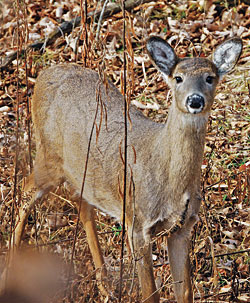 Alert animals, like this young doe, have a tendency to cause hunters to rush shots, which can be bad news. Game that is at ease and likely to wander through a wide open shooting lane greatly increase the chances of connecting with a well-placed arrow. |
Another important thing to remember is to take the right shot. A lot of people argue the right shot is the first good shot offered, and that can be the case. But in some scenarios this may not be true. In situations where game may have the tendency to stick around offering multiple shots (deer feeding on acorns or in agricultural fields), hunters might be better off letting the first rush of adrenaline wear off. Watching an animal as it contentedly feeds allows a hunter to unscramble the brain, recognize shot distance and angle and develop a calm demeanor while readying for the shot. This may take as little as 20-30 seconds, but it can make or break the opportunity.
Conclusion
Hunt long enough and it's bound to happen. Most bowhunters will experience a season or two that just go down in the books as laughably miserable. The good news is disastrous seasons can teach us plenty about how to move on and become better hunters. They can highlight holes in practice regimens, expose equipment that simply doesn't work well with our individual shooting styles and make plain the shortcomings of lazy stand setups. The cold, hard truth is most blown opportunities could have been prevented well ahead of time. Lost shooting confidence is often a result of decisions made well before the season.
